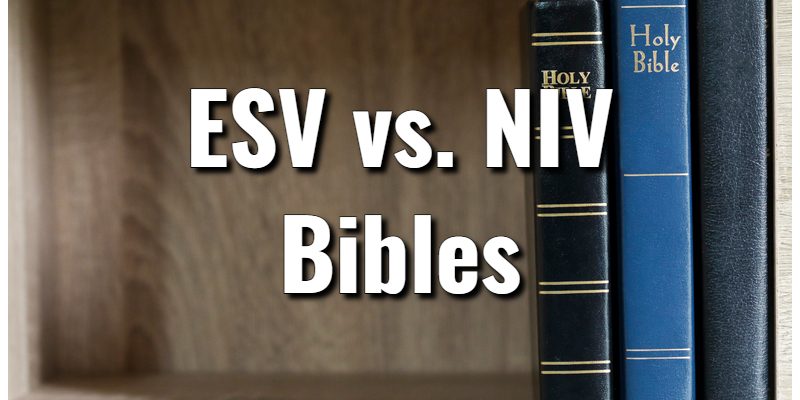This is part of Lord’s Library’s Bible Comparison Series. Our editors explore the ESV vs. NIV Bibles so you can understand the major differences between each translation.
When looking for a new Bible for yourself or as a gift, comparing the different Bible versions is an ideal first step. It’s also important that one considers the various Christian Church denominations when Bible shopping so the reader can be comfortable with their translation’s version of English. Some churches mandate a precise edition as well, while others may be curious about which version of the manuscript their favorite Bible translation comes from.
.If you’ve ever asked the question “What’s the difference between the ESV vs. NIV Bibles?” you’ve come to the right place. It’s in that spirit that our editors compiled this short resource by first offering a simple description of each Bible version, and then a comparison that highlights key contrasts. For each of the two Bible versions compared, Lord’s Library editors included links to our directories of the best editions, as well as the most popular products.
ESV vs. NIV Bibles
What is the ESV (English Standard Version)?
Of the more modern, meaning-for-meaning translated Bibles, the English Standard Version most closely walks the line between literal, word-for-word translating and attempting to convey the meaning above all else. The first complete ESV Bible was published in 2001 by Crossway, as a revision of the Revised Standard Version. The team of over 100 evangelical scholars and pastors had a unique philosophy in translating this Bible: “Emphasizes word-for-word accuracy, literary excellence, and depth of meaning.”
The ESV remains a popular choice among evangelical churches. That’s because of its unique ability to walk that line between honoring the literal translations that preceded it (such as the RSV) while conveying meaning and modern language in an accessible way. This view is not shared by all though, as some believe that while pursuing this goal the translators have made a few grave errors in theology.
What is the NIV Bible (New International Version)?
The New International Version was created to meet the need for a Bible in modern English using the earliest, highest-quality manuscripts available. The translators also aimed to create a reading of God’s Word that would be accessible to a wide audience in terms of language. The NIV Bible was translated by a team of 15 biblical scholars representing many different evangelical denominations.
The New International Version was first published complete in 1978 by Biblica, formerly known as the International Bible Society. Later revisions in 1984 and 2011 were created in light of new manuscript discoveries. It has become one of the best-selling modern translations on the market today. Modern criticisms include those who state that the NIV has significantly altered, or downright omitted, key passages that are present in the King James Version and other, older, literal translations.
ESV vs. NIV Bibles; What’s the Difference?
Both the English Standard Version and New International Version are modern Bible translations that emphasize easily accessible English. The English Standard Bible was crafted by a team of over 100 leading evangelical scholars and pastors with an emphasis on word-for-word accuracy and depth of meaning. Since its first publication in 2001, the ESV has proven to be a widely popular Bible for both worship and personal study.
The NIV is a few decades older but has updated versions as recent as 2011. At first glance, the easily accessible language and format of the NIV will closely resemble that of the ESV for many readers. But when you dig more deeply into their history, you will find that the translation philosophy from which they were produced differs slightly. The English Standard Version of the Bible was translated under a strict word-for-word philosophy while the New International Version was formed closer to a thought-for-thought philosophy (though still with a high priority on biblical accuracy).
The ESV used Biblica Hebraica Stuttgartensia as its basis for the Old Testament and the UBS Greek for its New Testament. The NIV used the same.
Lord's Library participates in affiliate programs. We may make a small commission from products purchased through this resource.
- What Does the Bible Say About Achievements? With Key Scriptures - April 11, 2025
- What does the Bible Say About Abortion? With Key Scriptures - April 11, 2025
- Prosperity Gospel Meaning in the Scriptures: Is it Biblical? - April 7, 2025














